
I’m very pleased to announce that in addition to my home office, my website is now bullfrogpowered® with 100% green electricity thanks to Ethical Host. It’s just one of many ways I walk the talk. To help you make a difference at work, here are nine tips to make your home office more earth-friendly.*
1. Use a chalkboard for ideas, to-dos and notes instead of paper. I like having my to-do list or projects list in front of my face, but I grew tired of managing scrap paper and rewriting notes when they got messy. I also wanted some motivational quotes nearby that I could change at will. Paint a chalkboard wall or board with VOC-free latex paint — available from Benjamin Moore in any colour — and use real chalk, not chalk pens. Wipe it off with an old sponge or a rag, rather than paper towels. Chalkboards are great for being non-committal. Get different colours of chalk to colour-code projects on a hand-made calendar, which could be a temporary or permanent feature.
2. Bullfrogpower your pad (if you know how much energy you use) and use energy-efficient lighting (LEDs or compact fluorescents). My monthly Bullfrogpower fee is less than $2, or about 10% of my electricity bill, but all of us together really adds up to a big positive impact! If you can, position your desk to take advantage of natural light. If you can see out a window, even better, so your eyes can get a break.
Continue reading 9 ways to green your home office »
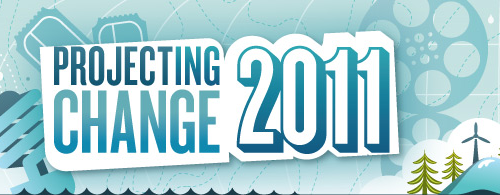
You might expect a film about a Vancouver couple who spend a year almost zero-waste and without buying any stuff to be a tale of unimaginable hardship and sacrifice. Indeed, the prospects of using the same toothbrush for 365 days, not replacing worn-out clothing, or making crackers from scratch are daunting but The Clean Bin Project‘s Jen and Grant take a delighted, energetic approach akin to Alisa Smith and J.B. MacKinnon’s The 100-Mile Diet, but on the screen. The project was for them a competition for who could produce the least amount of garbage by year’s end (I won’t tell you who won), and involved learning about plastics, asking for their cheese unwrapped in their reusable container, and making the most of an old razor. Their enthusiasm was infectious. The 76-minute film is merely a glimpse at an entire year, but if it suggests anything about the 525,600 minutes they spent saving the planet, I think they enjoyed most of them.
Their artistically delicious film intersperses their own narrative of discovery — and occasional humourous disappointment — with the broader view of our consumption-based lifestyle and its consequences: successful community recycling initiatives; the Pacific Garbage Patch (which is twice the size of Texas); albatross death by plastic; landfills; and incomprehensibly large volumes of disposable stuff as depicted by Seattle artist Chris Jordan.
Continue reading Talking trash: Projecting Change Film Fest opens May 26, and plastic is a Texas-sized problem »
I love GOOD Magazine for their content and design. I got a little emotional at work recently when I opened fifteen of their website’s articles just from their bottom-of-the-page grid — probably 95% of the content there. Inspired by their new “Overload” articles where an author with a similar habit to me — link-happy without enough time/energy to read everything in a day — posts snippets with links to interesting articles, here’s my first one. I might do this again later when I have lots to share but need to get my post out the door quickly.
Candy Chang is amazing. She’s started a community engagement project that uses stickers to enable people to imagine how neglected parts of New Orleans could be revitalized. You don’t have to be an urban planner to hope and dream about change in your community.
We’ve been saying all along that living sustainably is good for the economy too, and the New York Times reports that the Clean Air Act has benefits to the tune of $2 trillion annually by 2020. Time to leave the car at home more often, especially because sitting in traffic triggers more heart attacks than smoking and alcohol. Smoggy Los Angeles has a new bike plan that will hopefully deal with the pollution along with its street safety.
Continue reading Civic engagement by sticker, L.A. bike plan and other (mostly) good news »
I’ve known about London’s Unpackaged shop for awhile and, being the food lover and waste detester that I am, I’m very excited at the thought of visiting the shop when I travel to London this spring.
Check out their tantalizing photos and piece-de-l’existence at their website.
If London’s too far away, there’s a Food Coop in Port Townsend, WA. So next time you’re feeling plastic-free and hungry on your way to Seattle or Portland, or you’re a diehard Twilight fan, be sure to stop by. Supporting small businesses with these genuine values is incredibly important.
I really want one of those blueberry bars.
 This daily green blog challenge is in celebration of David Suzuki’s 75th birthday, supporting the David Suzuki Foundation. Please help me out by sponsoring me online now.
This daily green blog challenge is in celebration of David Suzuki’s 75th birthday, supporting the David Suzuki Foundation. Please help me out by sponsoring me online now.
Note: I am writing solely on my own behalf, and do not claim to represent the David Suzuki Foundation or its views here.

Bike parking at Stockholm Central Station. (Photo by
EURIST e.V. via Flickr)
I read quite a great article about Stockholm’s sustainable qualities last year and can’t find it, but here are some interesting new-to-me tidbits I dug up tonight:
This is awesome: the 250,000 or so people passing through Stockholm Central Station every day generate a lot of heat, and one Swedish company has figured out how to harness the otherwise wasted energy to heat a nearby building. The system “lowers the energy costs of the office block by as much as 25%.” (Via GOOD)
Hammarby Sjöstad, formerly a run-down industrial area in Stockholm, has been undergoing a metamorphosis since the early 1990s that has made it a model of sustainable urban development. From waste and wastewater management to renewable energy and active transportation, the community has an integrated plan with strict requirements and ambitious goals. GOOD talks about the community’s use of distributed energy, and it’s pretty exciting stuff.
Check out this Green City Guide on Stockholm’s other offerings, like a green hotel chain and organic treats, clothing and cosmetics.
 This daily green blog challenge is in celebration of David Suzuki’s 75th birthday, supporting the David Suzuki Foundation. Please support our work on climate change and safe cosmetics by making a generous donation online now.
This daily green blog challenge is in celebration of David Suzuki’s 75th birthday, supporting the David Suzuki Foundation. Please support our work on climate change and safe cosmetics by making a generous donation online now.
Note: I am writing solely on my own behalf, and do not claim to represent the David Suzuki Foundation or its views here.
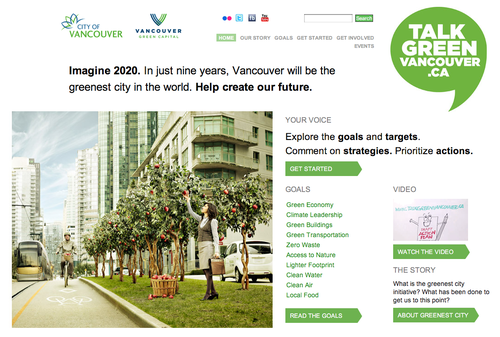
Come collaborate, brainstorm, and meet other green keeners (like me!) at the Greenest City Camp on Saturday, March 5th!
The “unconference” is “a full-day of learning, connecting and finding allies and collaborators to make Vancouver the Greenest City in the world by 2020. This is your chance to connect with Vancouver residents and organizations that are passionate about making this a green city and find out how we can move forward together. It’s about finding people, and the resources, to do what you always wanted to do”, like creating a laneway community garden with your neighbours or reducing waste at work.
If that didn’t already get you stoked, there will be food. Mmm, food! the connector of people.
And there’s more…
If you’re baffled by camp idea, sign up anyway and check out this camp prep webinar March 3.
The Greenest City Webinar on March 4 is kind of a “The Plan: 101” so if you’re not up to speed on this (which you should be, cos it’s awesome and exciting), this is your chance to sit back and get educated before the unconference.
And there are a couple zero waste events on March 2nd, with more info on the Talk Green Vancouver events page.
Now go register for the unconference!
 This daily green blog challenge is in celebration of David Suzuki’s 75th birthday, supporting the David Suzuki Foundation. Please help me out by sponsoring me online now.
This daily green blog challenge is in celebration of David Suzuki’s 75th birthday, supporting the David Suzuki Foundation. Please help me out by sponsoring me online now.
Note: I am writing solely on my own behalf, and do not claim to represent the David Suzuki Foundation or its views here.
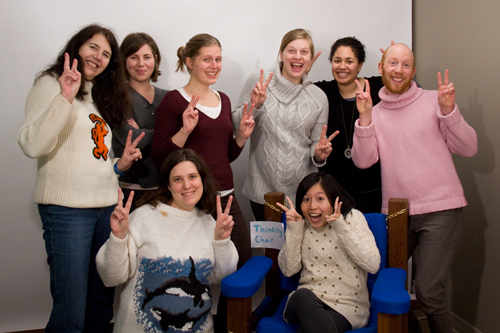
Today is National Sweater Day, WWF’s cheeky campaign to encourage us to collectively turn down our thermostats and embrace the (Ugly) Sweater. It turns out our woollies could go a long way to saving winter:
Turning down the thermostat by three degrees can make a big difference in fighting climate change. In fact, if every Canadian turned down their thermostat in the winter, we could save 2.2 megatonnes of carbon dioxide per year. That’s like taking 350,000 cars off the road. — WWF Canada
Yowsers. But forget the statistics for now, because Ugly Sweater day at the David Suzuki Foundation is a perfect excuse for a team photo. With one absentee, Creative Services did an impromptu photo shoot showing off our range of sweaters, from stylish to nostalgically ugly.
Got your own photo? Post the link here!
 This daily green blog challenge is in celebration of David Suzuki’s 75th birthday, supporting the David Suzuki Foundation. Please help me out by sponsoring me online now.
This daily green blog challenge is in celebration of David Suzuki’s 75th birthday, supporting the David Suzuki Foundation. Please help me out by sponsoring me online now.
Note: I am writing solely on my own behalf, and do not claim to represent the David Suzuki Foundation or its views here.
Above video via GOOD: Brooklyn’s Habana Outpost is a Mecca of Food and Sustainability
You’re probably familiar with 350.org‘s global citizen engagement on climate change at the local, grassroots level. I love hearing about these social and environmental change actions and, similarly, what self-propelled groups are doing in their own communities to improve their urban spaces, make cycling safer and save beached whales. The power we have as individuals is even greater when combined into collaborative forces. I highlight here some efforts in making our world better that may have been initiated by one person but thrive best with at least one other. I can remember in particular a community garden in Vancouver started by two women that not only resulted in local food, but better relationships between neighbours.
Continue reading Work in progress: Great things people are doing (together) for the planet »

El Naturalista (left), Simple sneaks
I’m going to start with the caveat: you cannot buy your way to sustainability. Consumerism is one of the major players in our swift and accelerating destruction of the planet. That said, when it comes to essentials, you’re unlikely to walk barefoot year-round in Vancouver. I’ve also included some non-essentials, although that depends on how much you love your iPhone. And making it look cool. That’s a fair quest in itself.
Also, when I say eco-friendly, I mean eco-friendlier, but I digress. So, in no particular order…
1 & 2: Green shoe, red shoe…
Oh-ho yes… eco-friendly shoes. This is for boys and girls. I wasn’t a shoe chick until I discovered Simple and El Naturalista. Simple has your sneakers, sandals, and boots in biodegradable, natural materials, including recycled tire tread! They’re not 100% perfect, but it sure beats plastic and other synthetics. (Cotton shoelaces!) Whether you’re a yoga mom, skater, hippy or hipster, these aren’t your hempy frumpy shoes of Woodstocks past. El Naturalista is higher-end (fancy-shmancy) but exquisite quality, offering a variety of juicy-coloured leathers. (Excuse me while I wipe the drool from my chin.) Before you take me to the cleaners on promoting leather here, I know that not all leather is treated equally, let alone the cows. Just consider where the fake leather (like vinyl) comes from. Spain’s El Naturalista, says their website, “seek out production processes that are eco-friendly and promote traditional craft skills, we utilize natural materials and dyes, we avoid toxic products and materials, and we practice conservation by using substances that are biodegradable and recyclable.” So while you tread lightly, you can also feel better about yourself. Plus they’re hottttt. The box for my shoes throughtfuly included a drawstring reusable bag to carry the box. (Oh my god, 25% off right now… no no, don’t need more shoes. Shush, Erika.)
Your second-best option? Ask for 100% rubber soles — they have a stickier grip to help you distinguish from the fakes, because the symbol is the same. I’ve been told something’s rubber when it’s clearly a composite. Other great shoe materials are cork, wool and organic fabrics. I’ve seen wood, but I don’t know how ergonomic it is. Take care of your leather using natural silicon or wax instead of harmful sprays.
Continue reading 5 green companies you should know about for things you didn’t know you could green »
Today I found myself feeling embarrassed that I reacted to a stranger’s not-eco-friendly act with something that, although gentle, ultimately got me nowhere because it got her back up. Despite my best attempts to be casual and compromise a little, I still made her feel like she’d done something wrong. It’s possible she didn’t know any better, or, I conceded to her, that she may not have the resources in her community. But I think I would have been better off asking, “You don’t have any recycling or donation facilities nearby, or none of your stuff was salvageable that way? That’s too bad!” Maybe it still would have come off as a criticism but at least it may have been more directed at her town instead of at her. Nobody likes to be questioned that way, and I always feel terrible if I think I’ve hurt someone else’s feelings.
It’s a sticky thing, having conversations that essentially challenge the way others live, whether it’s your own sister (I’ve failed pretty miserably at that), a friend, or a complete stranger. I’ve felt bad after casually saying, “No fat yogurt? That’s no fun!” to a friend, and it’s really hard to approach people about their synthetic fragrances because they’ll take that very personally.
Continue reading How do you talk about people’s (not so) green habits? »



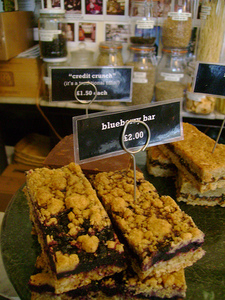 Photo by
Photo by 
 Bike parking at Stockholm Central Station. (Photo by
Bike parking at Stockholm Central Station. (Photo by 

 El Naturalista (left), Simple sneaks
El Naturalista (left), Simple sneaks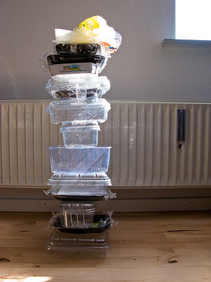 Photo by
Photo by